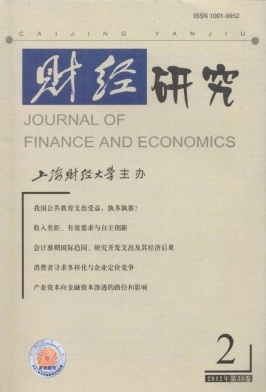收入差距、有效需求与自主创新
财经研究 2012 年 第 38 卷第 02 期, 页码:17 - 27
摘要
参考文献
摘要
文章利用中国地区层面的面板数据,实证检验了收入差距与自主创新之间的关系。研究发现,收入差距与中国自主创新呈倒"U"形关系,收入差距既可以通过扩大创新产品的需求规模促进国家或地区的技术创新,又可以通过抑制消费结构升级最终阻碍国家或地区技术创新能力的提升;收入差距对技术创新的影响存在显著的区域差异性,在东部和中部地区其影响显著为正,而在西部地区其影响为负但不显著;当前,我国大部分地区的城乡收入比均处于倒"U"形曲线的上升阶段,对这些地区而言,适当的收入差距促进了其自主创新能力的提升。
[1]范红忠.有效需求规模假说、研发投入与国家自主创新能力[J].经济研究,2007,(3):33-44.
[2]康志勇,张杰.有效需求与自主创新能力影响机制研究——来自中国1980-2004年的经验证据[J].财贸研究,2008,(5):1-8.
[3]劳伦斯.汉密尔顿.应用STATA做统计分析(第5版)[M].郭志刚等,译.重庆:重庆大学出版社,2008.
[4]刘冰.技术创新的消费推动论[J].科学管理研究,2007,(1):9-12.
[5]沈凌,田国强.贫富差别、城市化与经济增长:一个基于需求因素的经济学分析[J].经济研究,2009,(1):17-29.
[6]王俊,刘东.中国居民收入差距与需求推动下的技术创新[J].中国人口科学,2009,(5):58-67.
[7]Croix D,Doepke M.Public versus private education when differential fertility matters[J].Journal of Development Economics,2004,73(2):607-629.
[8]Eaton J,Kortum S.Technology,geography and trade[J].Econometrica,2002,70(5):1741-1779.
[9]Foellmi R,Zweimuller J.Income distribution and demand-induced innovations[J].Re-view of Economic Studies,2006,73(4):941-960.
[10]Greenwood J,Mukoyama T.The effect of income distribution on the timing of new product introductions[R].Working Paper,University of Rochester,2001.
[11]Hansen B E.Threshold effects in non-dynamic panels:Estimation,testing,and infer-ence[J].Journal of Econometrics,1999,93(2):345-368.
[12]Keller W.Trade and the transmission of technology[J].Journal of Economic Growth,2002,7:5-24.
[13]Nelson R R,Winter S G.An evolutionary theory of economic change[M].Cam-bridge,London:Belknap Press of Harvard University Press,1982.
[14]Schmookler J.Inventions and economic growth[M].Cambridge:Harvard University Press,1966.
[15]Savvides A,Zachariadis M.International technology diffusion and the growth of TFP in the manufacturing sector of developing economies[J].Review of Development Eco-nomics,2005,9(4):482-501.
[16]Zweimuller J.Inequality,redistribution,and economic growth[J].Empirica,2000,27(1):1-20.
[2]康志勇,张杰.有效需求与自主创新能力影响机制研究——来自中国1980-2004年的经验证据[J].财贸研究,2008,(5):1-8.
[3]劳伦斯.汉密尔顿.应用STATA做统计分析(第5版)[M].郭志刚等,译.重庆:重庆大学出版社,2008.
[4]刘冰.技术创新的消费推动论[J].科学管理研究,2007,(1):9-12.
[5]沈凌,田国强.贫富差别、城市化与经济增长:一个基于需求因素的经济学分析[J].经济研究,2009,(1):17-29.
[6]王俊,刘东.中国居民收入差距与需求推动下的技术创新[J].中国人口科学,2009,(5):58-67.
[7]Croix D,Doepke M.Public versus private education when differential fertility matters[J].Journal of Development Economics,2004,73(2):607-629.
[8]Eaton J,Kortum S.Technology,geography and trade[J].Econometrica,2002,70(5):1741-1779.
[9]Foellmi R,Zweimuller J.Income distribution and demand-induced innovations[J].Re-view of Economic Studies,2006,73(4):941-960.
[10]Greenwood J,Mukoyama T.The effect of income distribution on the timing of new product introductions[R].Working Paper,University of Rochester,2001.
[11]Hansen B E.Threshold effects in non-dynamic panels:Estimation,testing,and infer-ence[J].Journal of Econometrics,1999,93(2):345-368.
[12]Keller W.Trade and the transmission of technology[J].Journal of Economic Growth,2002,7:5-24.
[13]Nelson R R,Winter S G.An evolutionary theory of economic change[M].Cam-bridge,London:Belknap Press of Harvard University Press,1982.
[14]Schmookler J.Inventions and economic growth[M].Cambridge:Harvard University Press,1966.
[15]Savvides A,Zachariadis M.International technology diffusion and the growth of TFP in the manufacturing sector of developing economies[J].Review of Development Eco-nomics,2005,9(4):482-501.
[16]Zweimuller J.Inequality,redistribution,and economic growth[J].Empirica,2000,27(1):1-20.
引用本文
李平, 李淑云, 许家云. 收入差距、有效需求与自主创新[J]. 财经研究, 2012, 38(2): 17–27.
导出参考文献,格式为:





 7513
7513  4415
4415

